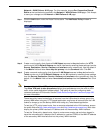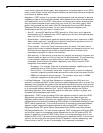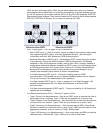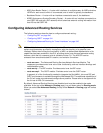
Network > Routing
334
SonicOS 5.8.1 Administrator Guide
OSPF does not have to impose a hop count limit because it does not advertise entire
routing tables, rather it generally only sends link state updates when changes occur.
This is a significant advantage in larger networks in that it converges more quickly,
produces less update traffic, and supports an unlimited number of hops.
• Routing table updates – As mentioned above, the practice of sending an entire routing table
introduces the problems of slower convergences, higher bandwidth utilization, and
increased potential for stale routing information. RIPv1 broadcasts its entire routing table
at a prescribed interval (usually every 30 seconds), RIPv2 can either broadcast or
multicast, and OSPF multicasts only link state updates whenever a change to the network
fabric occurs. OSPF has a further advantage of using designated routers (DR) in forming
adjacencies in multiple-access networks (more on these concepts later) so that updates do
not have to be sent to the entire network.
• Subnet sizes supported – RIPv1 was first implemented when networks were strictly class
A, class B, and class C (and later D and E):
• Class A – 1.0.0.0 to 126.0.0.0 (0.0.0.0 and 127.0.0.0 are reserved)
–
Leftmost bit 0; 7 network bits; 24 host bits
–
0nnnnnnn hhhhhhhh hhhhhhhh hhhhhhhh (8-bit classful netmask)
–
126 Class A networks, 16,777,214 hosts each
• Class B - 128.0.0.0 to 191.255.0.0
–
Leftmost bits 10; 14 network bits; 16 host bits
–
10nnnnnn nnnnnnnn hhhhhhhh hhhhhhhh (16-bit classful netmask)
–
16,384 Class B networks, 65,532 hosts each
• Class C – 192.0.0.0 to 223.255.255.0
–
Leftmost bits 110; 21 network bits; 8 host bits
–
110nnnnn nnnnnnnn nnnnnnnn hhhhhhhh (24-bit classful netmask)
–
2,097,152 Class Cs networks, 254 hosts each
• Class D - 225.0.0.0 to 239.255.255.255 (multicast)
–
Leftmost bits 1110; 28 multicast address bits
–
1110mmmm mmmmmmmm mmmmmmmm mmmmmmmm
• Class E - 240.0.0.0 to 255.255.255.255 (reserved)
–
Leftmost bits 1111; 28 reserved address bits
–
1111rrrr rrrrrrrr rrrrrrrr rrrrrrrr
This method of address allocation proved to be very inefficient because it provided no
flexibility
, neither in the way of segmentation (subnetting) or aggregation (supernetting,
or CIDR – classless inter-domain routing) by means of VLSM – variable length subnet
masks.
VLSM, supported by RIPv2 and OSPF, allows for
classless representation of networks
to break larger networks into smaller networks:
For example, take the classful
10.0.0.0/8 network, and assign it a /24 netmask. This
subnetting allocates an additional 16-bits from the host range to the network range
(24-8=16). To calculate the number of additional networks this subnetting provides,
raise 2 to the number of additional bits: 2^16=65,536. Thus, rather than having a
single network with 16.7 million hosts (usually more than most LAN’s require) it is
possible to have 65,536 networks, each with 254 usable hosts.
VLSM also allows for route aggregation (CIDR):


















